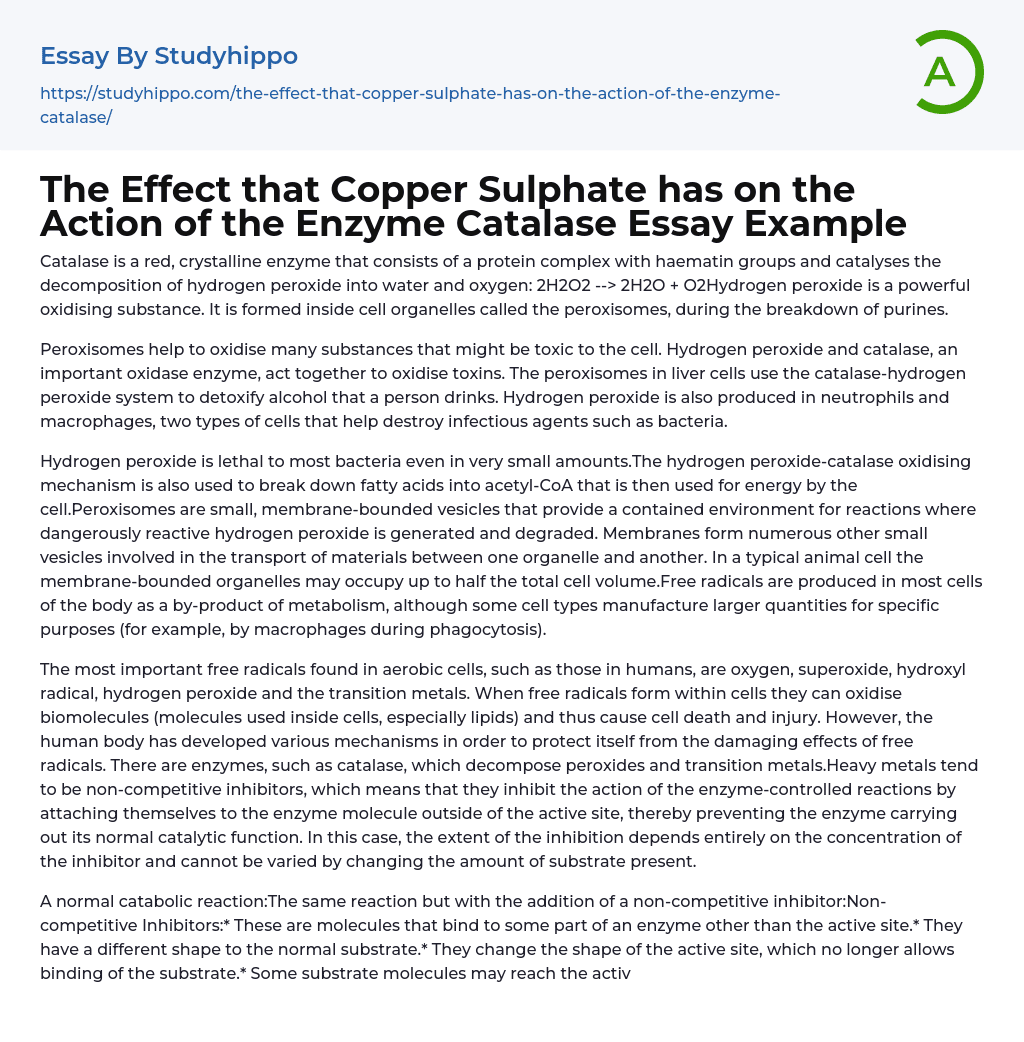

The Effect that Copper Sulphate has on the Action of the Enzyme Catalase Essay Example
Catalase is a red, crystalline enzyme that consists of a protein complex with haematin groups and catalyses the decomposition of hydrogen peroxide into water and oxygen: 2H2O2 --> 2H2O + O2Hydrogen peroxide is a powerful oxidising substance. It is formed inside cell organelles called the peroxisomes, during the breakdown of purines.
Peroxisomes help to oxidise many substances that might be toxic to the cell. Hydrogen peroxide and catalase, an important oxidase enzyme, act together to oxidise toxins. The peroxisomes in liver cells use the catalase-hydrogen peroxide system to detoxify alcohol that a person drinks. Hydrogen peroxide is also produced in neutrophils and macrophages, two types of cells that help destroy infectious agents such as bacteria.
Hydrogen peroxide is lethal to most bacteria even in very small amounts.The hydrogen peroxide-catalase oxidising mechanism is also used to break down fatty acids into
...acetyl-CoA that is then used for energy by the cell.Peroxisomes are small, membrane-bounded vesicles that provide a contained environment for reactions where dangerously reactive hydrogen peroxide is generated and degraded. Membranes form numerous other small vesicles involved in the transport of materials between one organelle and another. In a typical animal cell the membrane-bounded organelles may occupy up to half the total cell volume.Free radicals are produced in most cells of the body as a by-product of metabolism, although some cell types manufacture larger quantities for specific purposes (for example, by macrophages during phagocytosis).
The most important free radicals found in aerobic cells, such as those in humans, are oxygen, superoxide, hydroxyl radical, hydrogen peroxide and the transition metals. When free radicals form within cells they can oxidise biomolecules (molecules used inside cells, especially lipids)
and thus cause cell death and injury. However, the human body has developed various mechanisms in order to protect itself from the damaging effects of free radicals. There are enzymes, such as catalase, which decompose peroxides and transition metals.Heavy metals tend to be non-competitive inhibitors, which means that they inhibit the action of the enzyme-controlled reactions by attaching themselves to the enzyme molecule outside of the active site, thereby preventing the enzyme carrying out its normal catalytic function. In this case, the extent of the inhibition depends entirely on the concentration of the inhibitor and cannot be varied by changing the amount of substrate present.
A normal catabolic reaction:The same reaction but with the addition of a non-competitive inhibitor:Non-competitive Inhibitors:* These are molecules that bind to some part of an enzyme other than the active site.* They have a different shape to the normal substrate.* They change the shape of the active site, which no longer allows binding of the substrate.* Some substrate molecules may reach the active site before the non-competitive inhibitor.
* The rate of reaction is reduced.* Finally they leave their binding sites, but substrate molecules do not compete for these, so they have a greater inhibitory effect.How Will Copper Sulphate Affect Catalase?Catalase contains Fe in its active site (bound to a prosthetic group known as heme). Cu++ may inhibit catalase by displacing the Fe from the enzyme.
If the Cu is removed and Fe added back, activity would likely be restored. Cu++ can have other effects on enzymes. For example, the copper may be binding to negatively charged amino acids in the enzyme that are required for activity. This effect is easy to
envision if such an amino acid is in or near the active site of the enzyme. However, even amino acids at some distance from the active site (but still part of the enzyme) can influence activity if altering the amino acid changes the conformation of the protein such that activity is lost.
- Mutation essays
- Acid essays
- Calcium essays
- Carbohydrate essays
- Carbon essays
- Chemical Bond essays
- Chemical Reaction essays
- Chemical reactions essays
- Chromatography essays
- Concentration essays
- Copper essays
- Diffusion essays
- Ethanol essays
- Hydrogen essays
- Organic Chemistry essays
- Osmosis essays
- Periodic Table essays
- Ph essays
- Salt essays
- Sodium essays
- Titration essays
- Bacteria essays
- Biotechnology essays
- Breeding essays
- Cell essays
- Cell Membrane essays
- Cystic Fibrosis essays
- Enzyme essays
- Human essays
- Microbiology essays
- Natural Selection essays
- Photosynthesis essays
- Plant essays
- Protein essays
- Stem Cell essays
- Viruses essays
- John Locke essays
- 9/11 essays
- A Good Teacher essays
- A Healthy Diet essays
- A Modest Proposal essays
- A&P essays
- Academic Achievement essays
- Achievement essays
- Achieving goals essays
- Admission essays
- Advantages And Disadvantages Of Internet essays
- Alcoholic drinks essays
- Ammonia essays
- Analytical essays



